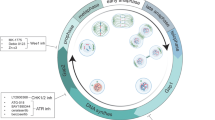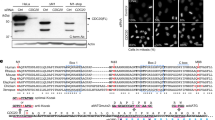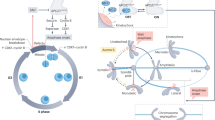Abstract
Chemicals that target microtubules induce mitotic stress by affecting several processes that occur during mitosis. These processes include separation of the centrosomes in prophase, alignment of the chromosomes on the spindle in metaphase and sister-chromatid separation in anaphase1,2. Many human cancers are sensitive to mitotic stress. This sensitivity is being exploited for therapy and implies checkpoint defects2,3,4,5,6,7,8. The known mitotic checkpoint genes, which prevent entry into anaphase when the chromosomes are not properly aligned on the mitotic spindle, are, however, rarely inactivated in human cancer9,10,11,12,13. Here we describe the chfr gene, which is inactivated owing to lack of expression or by mutation in four out of eight human cancer cell lines examined. Normal primary cells and tumour cell lines that express wild-type chfr exhibited delayed entry into metaphase when centrosome separation was inhibited by mitotic stress. In contrast, the tumour cell lines that had lost chfr function entered metaphase without delay. Ectopic expression of wild-type chfr restored the cell cycle delay and increased the ability of the cells to survive mitotic stress. Thus, chfr defines a checkpoint that delays entry into metaphase in response to mitotic stress.
This is a preview of subscription content, access via your institution
Access options
Subscribe to this journal
Receive 51 print issues and online access
$199.00 per year
only $3.90 per issue
Buy this article
- Purchase on Springer Link
- Instant access to full article PDF
Prices may be subject to local taxes which are calculated during checkout






Similar content being viewed by others
References
McIntosh, J. R. & Koonce, M. P. Mitosis. Science 246, 622–628 ( 1989).
Jordan, M. A. & Wilson, L. Microtubules and actin filaments: dynamic targets for cancer chemotherapy. Curr. Opin. Cell Biol. 10, 123–130 ( 1998).
Hartwell, L. H. & Kastan, M. B. Cell cycle control and cancer. Science 266, 1821– 1828 (1994).
Lengauer, C., Kinzler, K. W. & Vogelstein, B. Genetic instability in colorectal cancers. Nature 386, 623–627 ( 1997).
Lengauer, C., Kinzler, K. W. & Vogelstein, B. Genetic instabilities in human cancers. Nature 396, 643–649 ( 1998).
Elledge, S. J. Mitotic arrest: Mad2 prevents sleepy from waking up the APC. Science 279, 999–1000 ( 1998).
Amon, A. The spindle checkpoint. Curr. Opin. Genet. Dev. 9, 69–75 (1999).
Li, Y. & Benezra, R. Identification of a human mitotic checkpoint gene: hsMAD2. Science 274, 246 –248 (1996).
Cahill, D. P. et al. Mutations of mitotic checkpoint genes in human cancers. Nature 392, 300–303 ( 1998).
Cahill, D. P. et al. Characterization of MAD2B and other mitotic spindle checkpoint genes. Genomics 58, 181– 187 (1999).
Yamaguchi, K., Okami, K., Hibi, K., Wehage, S. L., Jen, J. & Sidransky, D. Mutation analysis of hBUB1 in aneuploid HNSCC and lung cancer cell lines. Cancer Lett. 139, 183–187 ( 1999).
Jin, D. Y., Spencer, F. & Jeang, K. T. Human T cell leukemia virus type 1 oncoprotein Tax targets the human mitotic checkpoint protein MAD1. Cell 93, 81–91 (1998).
Zou, H., McGarry, T. J., Bernal, T. & Kirschner, M. W. Identification of a vertebrate sister-chromatid separation inhibitor involved in transformation and tumorigenesis. Science 285, 418–422 (1999).
Hofmann, K. & Bucher, P. The FHA domain: a putative nuclear signalling domain found in protein kinases and transcription factors. Trends Biochem. Sci. 20, 347–349 (1995).
Lovering, R. et al. Identification and preliminary characterization of a protein motif related to the zinc finger. Proc. Natl Acad. Sci. USA 90, 2112–2116 (1993).
Borden, K. L. et al. The solution structure of the RING finger domain from the acute promyelocytic leukaemia proto-oncoprotein PML. EMBO J. 14, 1532–1541 (1995).
Murone, M. & Simanis, V. The fission yeast dma1 gene is a component of the spindle assembly checkpoint, required to prevent septum formation and premature exit from mitosis if spindle function is compromised. EMBO J. 15, 6605–6616 ( 1996).
Holliday, R. & Grigg, G. W. DNA methylation and mutation. Mutat. Res. 285, 61–67 ( 1993).
Furuno, N., den Elzen, N. & Pines, J. Human cyclin A is required for mitosis until mid prophase. J. Cell Biol. 147, 295– 306 (1999).
Zimmerman, W., Sparks, C. A. & Doxsey, S. J. Amorphous no longer: the centrosome comes into focus. Curr. Opin. Cell Biol. 11, 122– 128 (1999).
Weinert, T. DNA damage and checkpoint pathways: molecular anatomy and interactions with repair. Cell 94, 555–558 (1998).
Muhua, L., Adames, N. R., Murphy, M. D., Shields, C. R. & Cooper, J. A. A cytokinesis checkpoint requiring the yeast homologue of an APC-binding protein. Nature 393, 487–491 (1998).
Chehab, N. H., Malikzay, A., Stavridi, E. S. & Halazonetis, T. D. Phosphorylation of Ser-20 mediates stabilization of human p53 in response to DNA damage. Proc. Natl Acad. Sci. USA 96, 13777–13782 (1999).
Janss, A. J. et al. Caffeine and staurosporine enhance the cytotoxicity of cisplatin and camptothecin in human brain tumor cell lines. Exp. Cell Res. 243, 29–38 ( 1998).
Acknowledgements
We thank G. Maul for the gift of autoimmune serum Ab598; A. Janss for advice on cell synchronization; J. Bothos, M. Summers, M. Appel and M. Shayhorn for technical help; M. Scolnick for editing the manuscript; and E. Stavridi, N. Chehab, G. Rovera, F. Rauscher III and P. Leder for comments and advice. We also thank the Wistar Institute's NCI-supported Microscopy, Sequencing and Bioinformatics Facilities for technical help and access to their equipment. D.M.S. is supported by an NCI Training Grant awarded to the Wistar Institute.
Author information
Authors and Affiliations
Corresponding author
Rights and permissions
About this article
Cite this article
Scolnick, D., Halazonetis, T. Chfr defines a mitotic stress checkpoint that delays entry into metaphase. Nature 406, 430–435 (2000). https://doi.org/10.1038/35019108
Received:
Accepted:
Issue Date:
DOI: https://doi.org/10.1038/35019108
This article is cited by
-
Ubiquitin ligase CHFR mediated degradation of VE-cadherin through ubiquitylation disrupts endothelial adherens junctions
Nature Communications (2023)
-
Ubiquitination of CLIP-170 family protein restrains polarized growth upon DNA replication stress
Nature Communications (2022)
-
Childhood DNA methylation as a marker of early life rapid weight gain and subsequent overweight
Clinical Epigenetics (2021)
-
Genotoxic effect of saccharin on Allium cepa root tips
Biologia (2021)
-
Cytotoxic and genotoxic assessment of agricultural soils from an industrial region
Environmental Monitoring and Assessment (2021)
Comments
By submitting a comment you agree to abide by our Terms and Community Guidelines. If you find something abusive or that does not comply with our terms or guidelines please flag it as inappropriate.



